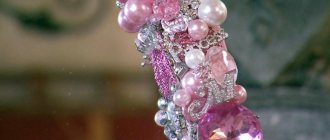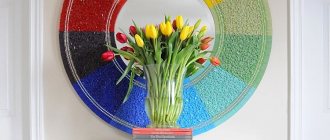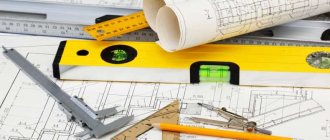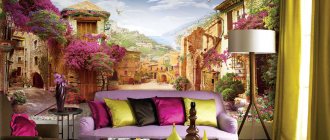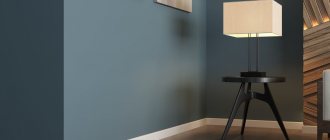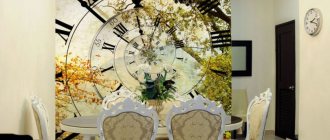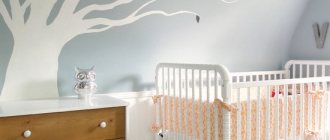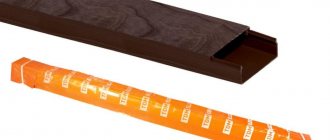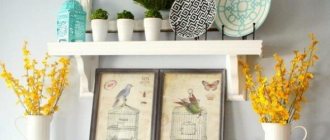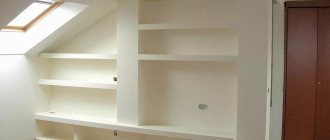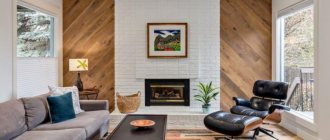According to archaeologists, people used mirrors back in the Stone Age, rubbing pieces of tin, gold or platinum until they shine. But the prototype of the modern glass mirror appeared only in 1240, when people learned to blow glass bottles. The inside of the bottle was covered with a layer of metal and broken. The fragments were used as a mirror. They learned to make a flat mirror only at the beginning of the 16th century in France.
The modern glass mirror is familiar to everyone and is a sheet of polished glass, on one side of which a thin layer of metal called amalgam is sprayed. Aluminum is used in the manufacture of budget mirrors, and silver – in expensive ones. The metal film is covered with a layer of varnish on top to protect it from external influences. Therefore, when attaching a mirror to the wall, you must work very carefully so as not to accidentally damage the delicate mirror coating and the glass itself.
Today, when creating the interior of premises, mirrors are widely used, thanks to which you can change the space by visually expanding the walls of the room or raising the ceiling. I also decided to visually enlarge my hallway and hung a large mirror on a column protruding from the wall. The mirror also serves its intended purpose, allowing you to see yourself in full height. My wife really liked the presence of a large mirror in the hallway.
Features of mounting a mirror on the wall
When attaching a mirror sheet to a wall, it is important to take into account all the features of this process. After all, the further use of the mirror for its intended purpose or its aesthetic appearance will depend on the correct installation. The fastening for a mirror on the wall must be made so that the canvas adheres well to the wall, and also so that the owners of the home can comfortably use the mirror.
The fastening for a mirror on the wall must be made so that the canvas adheres well to the wall, and also so that the owners of the home can comfortably use the mirror.
At what altitude
An important feature of installing a mirror surface is its height. Typically, the height of the mirror depends on the room in which it is installed. The height of the owners also plays an important role.
It is acceptable for a bathroom mirror to be mounted so that its middle is at eye level. Of course, not all residents are the same height. Therefore, the average value is taken. It corresponds to 160-165 centimeters from the beginning of the wall.
It is acceptable for a bathroom mirror to be mounted so that its middle is at eye level.
In corridors and hallways the mirror is usually elongated. It reflects a person in his full height. Therefore, the mirror sheet is mounted at a height of 168-170 centimeters from the floor.
In corridors and hallways the mirror is usually elongated.
If the reflective surface is hung on a cabinet door, then focus on its upper edge. If the wardrobe has a large height, the mirror is hung at a height of 170 centimeters. Thus, it turns out that the mirror surface is installed several centimeters above the heads of the owners of the house.
If the reflective surface is hung on a cabinet door, then focus on its upper edge.
Beautiful ideas
An interesting hallway, where the entrance area is separated by a high cabinet, and on the other side there is a place to relax and put yourself in order. The full-length model was placed on the front of the closet, and the makeup product was equipped with lighting and hung on the wall.
A mirror can be used in any interior; its size, shape, location, as well as the style of the frame are important.
Some interiors successfully combine a mirror that reflects full-length and waist-length. A large product can be hung on the front of the door, and a compact product can be hung on the side wall. The glare of light from the lighting creates interesting special effects and makes the hallway brighter.
A mirror can become one of the accents of space design
A large mirror located on the side of the door helps you evaluate your appearance before going outside. The massive frame echoes the texture and color of the floors and doors, together creating a cohesive composition.
In a gilded frame it will decorate any interior in a classic style. It can be hung above a table or chest of drawers where the necessary accessories will be stored. A free side wall is suitable for this composition.
Built-in wardrobe with gilding and floral patterns fits perfectly into a luxurious Baroque interior
If possible, place it on the same wall as the door. You can only see your reflection when leaving the house.
Combining it with a wardrobe saves space and helps organize your wardrobe storage space. A cabinet with a mirrored front is often placed sideways to the door.
Designer hallway in a classic style
Despite education, superstitions, one way or another, become a cause of doubt for almost all people. We hear them since childhood, constantly linking our troubles with signs. Therefore, before hanging a mirror opposite the door, listen to your feelings. If in doubt, it is better to choose one of the alternative options.
Features of attaching mirrors to different surfaces
Mirror sheets are installed on various surfaces and the installation method is connected precisely with this. Therefore, you need to know about the features of attaching mirrors to different types of walls. Popular installation options and rules will be discussed below.
Mirror sheets are installed on various surfaces and the installation method is connected precisely with this.
Concrete
A concrete wall is a fairly common construction material. Of course, there is no point in mounting a mirror on bare concrete walls. First, such a surface is puttied and plastered, and then coated with a primer. Only after this can the reflective sheet be glued to the wall. But that rarely happens. Usually, a hole is first made in the wall using a hammer drill, and then the mirror is screwed in using dowels.
Usually, a hole is first made in the wall using a hammer drill, and then the mirror is screwed in using dowels.
Drywall
How to hang a mirror on a plasterboard wall? Plasterboard panels are an unreliable and fragile facing material. Therefore, when attaching a mirror sheet to them, it is important to know its weight. You cannot screw a mirror that weighs more than 20 kilograms onto drywall.
If we talk about average values, then for every square meter of mirror surface there are from 5 to 15 kilograms.
Typically, in this case, a butterfly dowel or glue along with masking tape is used as a fastening for the mirror.
You cannot screw a mirror that weighs more than 20 kilograms onto drywall.
PVC panels
Attaching a mirror sheet to a wall lined with plastic panels should only be done using silicone glue. After all, you cannot drill holes in this material. Otherwise it will crack and become deformed.
Attaching a mirror sheet to a wall lined with plastic panels should only be done using silicone glue.
Tile
The mirror is usually glued or screwed to the tile using special holders (hardware). If the first method was chosen, then a silicone compound should be used as glue. Before this, ceramic tiles must be thoroughly degreased and cleaned. In the case of hardware, they are attached to the space between the tiles, in the so-called seams.
The mirror is usually glued or screwed to the tile using special holders (hardware).
Painted wall
The mirror is screwed onto painted walls using dowels and screws. In hardware stores you can now find a hidden mount that looks like an interior detail. Before fastening, the wall is marked and holes are made in it for metal fastenings.
The mirror is screwed onto painted walls using dowels and screws.
Work technology
A mirror is glued to a concrete wall like this:
- Turn the mirror back.
- Glue pieces of thick double-sided tape onto it.
- Remove the protective shell/film from it.
- Apply adhesive to the back side along the contour. It is advisable to do this in small pyramids.
- Next, the glue is applied to the surface in equal stripes - 15-20 cm.
- After the adhesive has already been applied, the mirror is pressed tightly against the wall.
- It is advisable to support the canvas with something from below, since the glue will set firmly only after 30-40 minutes. Double-sided tape performs the same function. Until the glue hardens, there is no need to tear off the tape; it will maintain a stable position of the canvas.
If the mirror is small, then only the contours are processed with a “liquid nail”. Some craftsmen advise using special holders for a while until the sealant hardens.
Methods for attaching mirrors
As mentioned above, each surface has its own options for attaching a mirror sheet. Each mounting method will be discussed below.
On glue
If the master decides to mount the mirror with glue, then he must choose a special adhesive composition for mirror surfaces. Typically, such compositions have good adhesion to walls made of different materials. Therefore, it will be reliable to glue heavy mirror products onto them.
Before starting work, the side on which the glue is applied is well cleaned and degreased with an alcohol solution. Then, after thorough drying, you can apply glue. This is done in the form of a snake strip or dotted in a checkerboard pattern. After this, the canvas is firmly pressed against the wall and held for several seconds.
With such fastening, it will not be possible to remove the mirror from the wall in one piece. You will have to break it, remove it piece by piece, and then clean the glue from the surface.
If the master decides to mount the mirror with glue, then he must choose a special adhesive composition for mirror surfaces.
For liquid nails
The mirror product is attached to liquid nails in almost the same way as to glue. Before starting the process, the surface is also degreased and the adhesive composition of liquid nails is applied to it. This is done in such a way that the glue does not come out over the edges when gluing.
It is important to first glue the mirror to the surface, then slowly tear it off and re-glue it. This method will help the mirror surface to better adhere to the wall surface.
It is important to first glue the mirror to the surface, then slowly tear it off and re-glue it.
For hangers, loops and hooks
If the owner plans to remove the mirror in the future or replace it with a new one, you can attach it to the wall using all kinds of holders, loops and hooks. These fasteners come in through and regular types. Conventional hangers are installed directly on the wall surface. The 4 edges of the mirror are inserted into them. Before installing the hangers, the wall is marked with a pencil. It is taken into account that the holders should be located 3 millimeters further than the mirror itself.
When there are holes in the mirror sheet, through fastening is used. In this case, self-tapping screws and dowels act as holders, which are then decorated with caps and overlays. Before installing them, you also need to correctly mark the wall and make holes in it for the dowels.
You can also use special hooks as fastenings. To do this you will need thread, the hooks themselves and 2 screws.
If the owner plans to remove the mirror in the future or replace it with a new one, you can attach it to the wall using all kinds of holders, loops and hooks.
On tape
If the mirror is relatively light in weight, it can be attached to a special 3M adhesive tape. The thickness of this tape ranges from 0.8 to 1.5 millimeters, and the width of the tape itself reaches 25 millimeters.
First, the backing is wiped with a degreasing compound. Next, small pieces are cut out of the tape and glued to the canvas in a chaotic manner. The distance between the pieces should not exceed 10 centimeters. At the end, the film protecting the adhesive is removed from the tape, and the mirror is installed in the right place. If necessary, it can be corrected.
If the mirror is relatively light in weight, it can be attached to a special 3M adhesive tape.
Drilling holes
You need to drill holes in the wall when the mirror product is heavy. At the same time, a hole is also drilled in the mirror to install the holder on it. In some cases, the mirror already has hooks or loops for hanging.
They also drill holes in the wall when, in addition to mounting hardware, it is impossible to attach a mirror to the wall. For example, in the bathroom with glue or mounting tape.
You need to drill holes in the wall when the mirror product is heavy.
Using plates
Construction stores sell special plates that hold the mirror sheet on the wall. They are also called hidden mounts. The plates themselves are glued to the glass using an adhesive on the plate. Next, the mirror product is attached to the wall using a self-tapping screw and a hole in the plate.
Construction stores sell special plates that hold the mirror sheet on the wall.
Other possible options
You can also attach the mirror to the surface using staples sold at a hardware store. The brackets have a through fastening into which a self-tapping screw is threaded and secured to the wall. The bracket itself supports the mirror and prevents it from falling.
The staples will be very useful for those who do not want to drill holes in the glass.
You can attach the mirror to the surface using staples sold at a hardware store.
Cut the board you need
When choosing a board from which to cut a tenon, consider the size and location of the mirror. Very heavy mirrors may require 2 cm thick boards. However, most mirrors can be secured using 1.5 cm thick boards. The board should be wide enough to accommodate several rows of screws.
For my mirror, I chose a board 15 cm wide. To cut it, you need to set the blade at an angle of 45 degrees, position the fence so as to cut out the center and saw the board. Use a table saw to cut pieces to the width of the mirror.
French tenons can be made by cutting the board at a 45-degree angle with a circular saw, but this method is much more complicated. The table saw makes extremely precise cuts to ensure a straight and stable installation. If you're using a circular saw, clamp a straight edge along the length of the board to create a fence that will help ensure precision and safety when cutting.
Rospotrebnadzor warned of restrictions after COVID vaccination
The robbers took the car. The church community gave the mother of 4 children another
“It’s always difficult to find people”: Averbukh about the difficulties in recruiting participants for the show
The nuances of mounting large mirrors on the wall
It is advisable to attach large mirrors to the surface using hardware or decorative screws. After all, only they can withstand such a huge weight. Scotch tape and glue will not be reliable here.
Before installing a large mirror sheet, it is important that the wall is level and prepared. To do this, it is checked for differences, leveled, if necessary, and primed. Next, the wall is marked so that the fastenings are installed proportionally. Some craftsmen make a hidden stand from a wooden or metal block so that the mirror has additional support.
It is advisable to attach large mirrors to the surface using hardware or decorative screws.
Spectacular examples in the interior
The mirror must be selected taking into account the existing interior and the overall design of the room. Below you can see several examples with the help of which the deficiencies in the configuration of the room were corrected or the emphasis was placed on successful features of the layout.
The mirror can be mounted on almost any surface. The main thing is to correctly calculate the amount of fasteners and make sure that the wall can withstand the load.
Did you manage to solve your problem using the recommendations from the article?
Yes!
46.83%
No. More answers required. I'll ask in the comments now.
37.24%
Partially. There are still questions. I'll write in the comments now.
15.94%
Voted: 709
Options for mounting mirrors on bathroom walls
There is high humidity in the bathroom and there is always a lot of fumes. Therefore, the mirror product must be securely attached to the wall. How then to glue a bathroom mirror to the wall? For this you can use:
- Adhesive sealant;
- Either metal through and conventional fastenings;
- Hidden plates are also used in bathrooms;
- Butterfly dowels.
It is worth remembering that if there are tiles in the bathroom, the fasteners should not be located on it, but in the seams. If the cladding is made of plastic panels, the mirror is glued. But its weight should not be very large.
The mirror product must be securely attached to the wall.
What glue to use
Determine exactly the composition with which the mirror will be attached. For this use:
- liquid Nails;
- special glue for mirrors.
To install mirror panels, you must choose a special glue that does not contain components that damage the amalgam (mirror layer). The most popular and frequently used mirror adhesive is Bostik 2750MS. The advantage of this glue is that the wall under it does not need to be primed. The adhesive has good performance characteristics and adhesion and can be used for gluing various surfaces.
In addition to this glue, brands such as SOUDAL, Abro and Tytan have proven themselves well.
When installing a mirror on ceramic tiles in the bathroom, it is better to choose a polymer and moisture-resistant adhesive.
How to glue mirror tiles on walls
Mirror tiles look very impressive and aesthetically pleasing in any interior. But how to glue beveled mirror tiles to the wall? First of all, you need to know that the base under such cladding must be perfectly level. If it has been determined that there are differences on the wall, the surface is plastered. When it comes to large differences, you cannot do without plasterboard sheets. Next, the installation of beveled mirror tiles proceeds as follows:
- The entire required surface is treated with a primer and the wall is allowed to dry completely.
- Next, you need to draw a line on the wall and mark where the tiles will be located. When marking, the location for grouting is taken into account.
- After this, special mirror glue is applied to each tile. She presses herself tightly against the wall for several minutes. The installation itself must be done from floor to ceiling.
- After 4-5 hours you can grout the seams. This is done with the same glue that was used to glue the tiles. However, you can use another grout.
- At the end, excess grout is removed from the seams.
If the mirror tile does not fit, it is cut with a glass cutter.
Mirror tiles look very impressive and aesthetically pleasing in any interior.
Tips and recommendations for choosing ways to mount mirrors on walls
To install a mirror sheet in any room correctly, it is important to take into account the recommendations of professional craftsmen. They will be given below:
- You can glue a mirror to tape only if it weighs up to 2 kilograms;
- Before installing the mirror using any of the proposed methods, it is recommended to stick a special anti-fragmentation film on it. Even if it breaks, it will not shatter into small pieces;
- When attaching a mirror to a tile, the fasteners should be screwed into the seams and not onto the tile;
- If the room is small, it is better to install a mirror opposite the window. This will visually increase the space;
- Before installing a mirror product in the bathroom, you must treat its edges with silicone sealant to prevent the development of mold;
- It is better to attach two sconce lamps on the sides near the mirror in the hallway. This way you can increase the space and create the effect of diffused light.
It is better to attach two sconce lamps on the sides near the mirror in the hallway.
All these tips will help you install the mirror safely, competently, and also aesthetically.
Useful tips
- When choosing materials for fastening, give preference to reliable manufacturers who have been releasing products on the market for more than one year and have few complaints. You can get maximum information on the relevant thematic forums.
- Do not use glue that has expired.
- Prepare the surface for work: eliminate obvious pits and protrusions, level. If a mirror hangs on a wall with defects, it will be under stress and will eventually burst.
- After hanging the mirror, do not touch it for 3-4 days - let it harden.
- If the mirror weighs 2 kilograms or more, secure it mechanically or add a small stand or several fasteners.
- When choosing a place, keep in mind that a mirror installed opposite the window opening visually expands it and makes it lighter.
If you are not sure that you can cope with the task, involve experts in the work. If you are overcome by passion and the desire to do everything yourself, don’t be a coward, but don’t rush forward as if to storm. Read several articles on the topic, ask for advice from people with experience - after all, it is important to take into account the quality of materials, the features of the canvas, and dimensions.
